After having learned some natural open chords, it’s time to learn chords with flats (♭) and sharps (#). In this article, we will learn the Bb Chord aka B flat chord on Guitar, and some of its variations. Before you get started, rest assured that there are no major differences in learning natural chords and chords with flats and sharps.
You can master both easily by knowing the same fundamental building blocks of how chords are formed. Familiarizing yourself with the basic shapes all the different positions of the Bb guitar chord on the fretboard is a great place to start so to help out we’ve provided chord charts, videos, and some expert insight to help you along the way.
Here Are the Common Bb Chords and How to Play Them on Guitar
1. Bb Major – Barre Chord
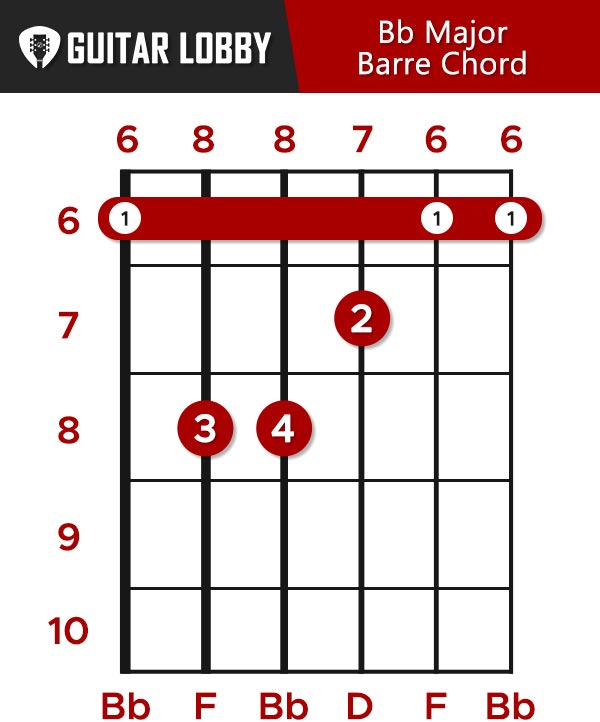
The only major setback of chords with flats and sharps like the Bb Major chord is that you can’t play any of them in open chord positions, at least not in standard tuning. That’s one reason familiarizing yourself with barre chords is so valuable.
Might sound a bit tricky if you are new to guitar, but just follow the chord chart below and you will have no problems.
- Put your first finger (index) as a barre on the 6th fret while applying pressure to all 6 strings.
- Put your second finger (middle) on the 7th fret of the G string.
- Put your third finger (ring) on the 8th fret of the A string.
- Put your fourth finger (pinky) on the 8th fret of the D string.
Start by placing the barre with your first finger and then your fingers starting from the top string (A) to the bottom string (E). This way you have a solid foundation with a good hand position to build and play the chord.
Tips, Tricks, and Common Challenges
The main challenge of playing this Bb Major chord, like any other barre chord, is to get the barre just right for all the notes of the chord to ring out nice and clean.
As a general rule of thumb, if you struggle with getting enough pressure on the strings and/or the barre feels hard on the hand, try to place your thumb as close to the center of the back of the guitar neck as you can. What this does is places your wrist in a more advantageous position and take some pressure off the left hand.
Expert Insight – If you are still having trouble, pay close attention to where you are feeling the pain/struggle.
Finger Pain – This is normal when you just started playing and should not worry too much about it. After enough time practicing you will build up strength and dexterity. You will also build up calluses so the tips of your fingers don’t get sore and rubbed raw.
Wrist Pain – The pressure on the hand and the sometimes not natural position of the wrist can translate into some pain and discomfort. One way to handle that is to try out different positions while holding your guitar. You can try sitting in the classical guitar position, seated on a stool, or standing up and see which is most comfortable for you.
It’s important to get your thumb in the center of the back of the neck so you are not over-stressing the muscles in your wrist and hand to reach for and fret each not.
Forearm Pain – If you feel any pain on the inner part of the arm, this is typically from pushing down too hard on the notes. This is common with new players if you haven’t built up some playing strength yet. Take a pause and allow your arm to rest. With practice, you will find that fretting the notes becomes easier over time as you build up your strength.
Brief Music Theory – To understand the Bb major chord we should go back to the formula of the Major scale. A major chord is made up of the 1st, 3rd, and 5th intervals in the major scale.
The number above refers to each of the notes of the Bb Major scale where each note corresponds to one number from 1 to 7.
The notes of the Bb major scale are:
| B♭ | C | D | E♭ | F | G | A |
| 1 | 2 | 3 | 4 | 5 | 6 | 7 |
If the formula of any major chord is made up of the 1st (the root note), 3rd, and 5th intervals, then the B flat Major Chord is formed by the notes Bb, D, and F.
Try this exercise out! One cool way to learn the fretboard is to say each note of the chord out loud as you play them individually. Doing that consistently when practicing will ultimately help you to memorize the notes on the fretboard. And, if you want to improve your ear and voice, don’t just spell the names of notes – try to sing them!
If you want to take it to the next level try this exercise! Hold the Bb major chord position and play only the Bb note on the low E string, then try to sing the D note or the F note. Doing this will improve your ear for pitch drastically and play a huge difference in your guitar playing skills.
2. Bb Barre Chord – Variation 2
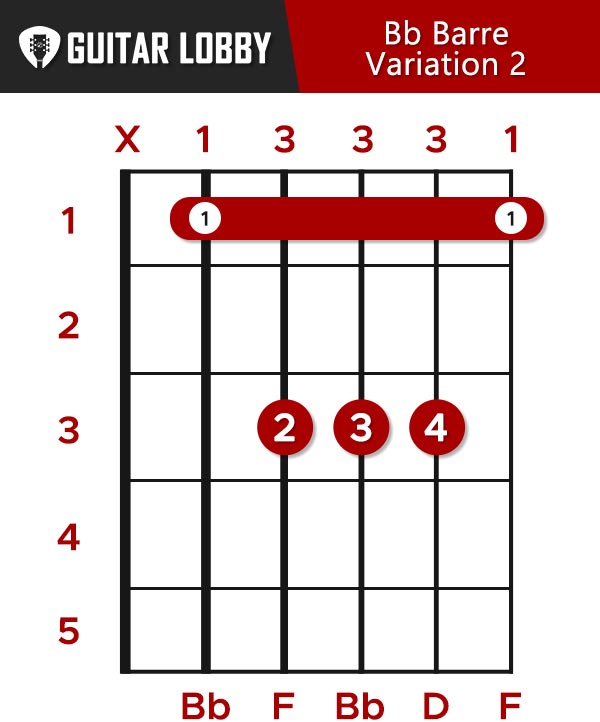
As with all chords, there are many ways to play the Bb Major chord. The next variation of the Bb Major is another type of Barre chord, this time with the root of the chord (the Bb note) on the A string.
If you are new to these chord shapes or to barre chords in general, we will teach you 2 ways to play this chord – then it’s up to you to choose the one that fits you best.
The fingering for the first variation is the following:
- Barre your first finger (index) across the 1st fret of the A, D, G, B, and high E strings.
- Place your second finger (middle), third finger (ring), and fourth finger (pinky) all respectively on the 3rd fret of D, G, and B strings as shown above.
2. Bb Barre Chord – Variation 3
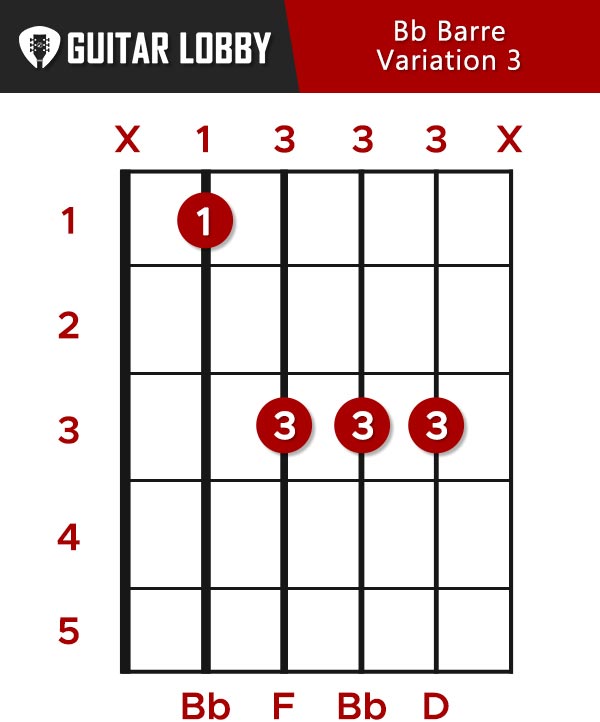
The next shape of this B flat major barre chord is similar to the last variation but is easier for some to play, as it avoids the challenge of compressing 3 fingers on the small space of the 3rd freet. It does however compromise the high E strings, which usually does not ring out on this chord shape for most guitarists.
- Put your first finger (index) on the first fret of the A string.
- Put your ring third finger (ring) or your fourth finger (pinky), whichever feels best for you, as a bar for the 3rd fret of D, G, and B Strings.
Whichever chord shape you choose to use is perfectly fine. Depending on the song you are playing you can also alternate shapes as you see fit. As long as you are comfortable with the fingering and can make everything note ring out clean without applying too much pressure on the hand.
Tips, Tricks, and Common Challenges
The Challenge of this Bb Major barre chord variation is to apply enough pressure to the bar if you choose to play it with a barre on the 3rd fret.
The bar can be tricky, especially in the first 3 frets where the frets are wider which requires a bit more of a stretch with your hand to reach all the notes.
One solution is to use your pinky for the bar since you don’t need to stretch and also to use the “classical” way of holding the guitar. If you are struggling or feeling discomfort, start by making sure you have good hand/wrist positioning.
Expert Insight
Now that we have the chord down and know what to play, let’s take a look at what not to play – an equally important subject. Never play the open E when strumming this shape of the Bb Major chord. One easy way to avoid this is to gently touch the Low E String with the upper part of the flesh from the index finger. Just a slight touch will do to mute the string and assure that you can strum without worrying about any unwanted sound.
4. Bb Major Chord – Variation 1
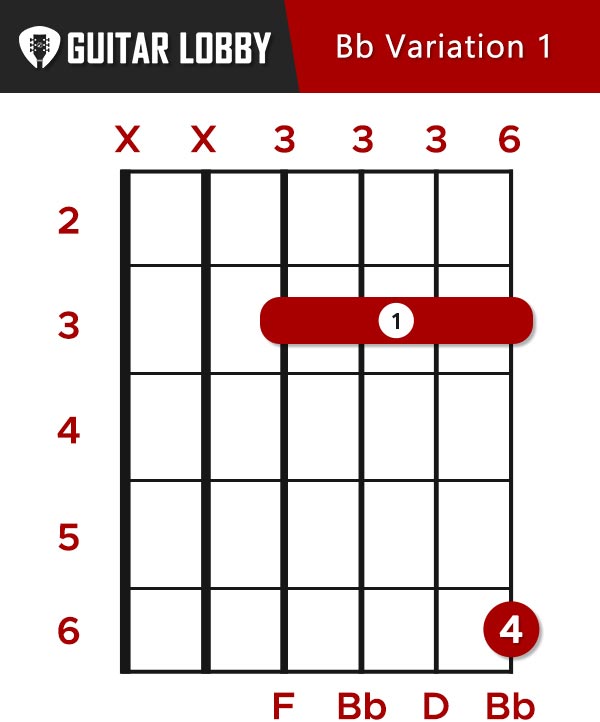
This variation of the Bb Major chord is less common but can spice up your playing and sound very interesting if implemented correctly in your playing. This particular variation is a way of transforming the barre chord and adding a higher note on the top end.
The fingering shape is as follows:
- Barre your first finger (index) on the 3rd fret of the D, G, B, and high E string.
- Put your fourth finger (pinky) on the 6th fret of the High E string.
This chord is part of a more complex system of chords called spread triads, which are your next level of chord mastery on guitar. This chord in particular is very useful and easy to play.
Tips, Tricks, and Common Challenges
This chord has a relatively big stretch for the pinky from the 3rd to the 6th freet. But if you have good wrist and hand positioning as explained above, you should have too much trouble.
Another challenge is not hitting the A and low E String. From the A string, you can apply the concept explained above and mute the low E string with the very tip of your Index finger.
Expert Insight
One important thing to notice about this chord is that It does not have a “bass” note. That means it only has notes from mid-range frequency and no low notes, which are found on the A and low E strings. That makes this chord a great option when you play with a bass player who fills your band’s mix, while you provide higher notes.
But if you are playing guitar by yourself you would prefer to use a position that includes notes from the A and E string – that would make the chord sound more “full”.
5. Bb Major Chord – Variation 2
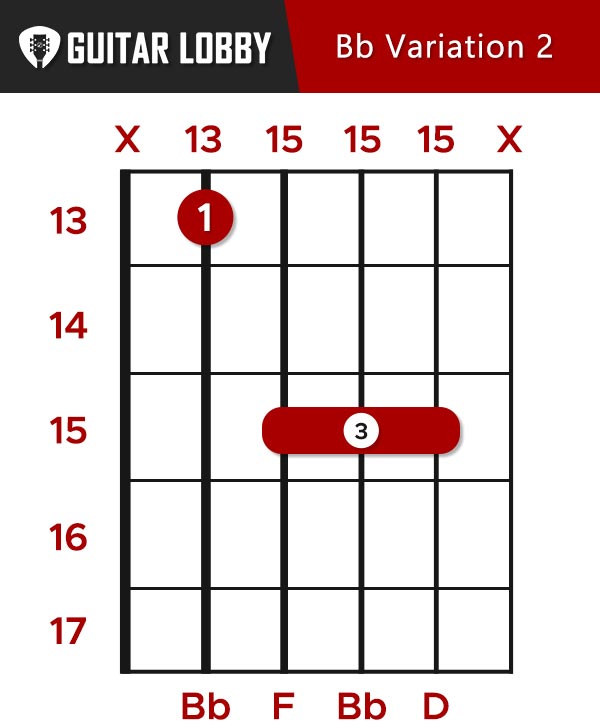
You can also play the same shape of the Bb Major bar chord with a root on the A string up on a higher octave – which means play it 12 frets above the original position.
Follow the following fingering for this chord variation:
- Put your first finger (index) on the 13th fret of the A string.
- Barre your third finger (ring) on the 15th fret of the D, G, and B string.
Tips, Tricks, and Common Challenges
As with the original shape, 12 frets below, the challenge is to mute the low E string with the tip of your index finger.
Also, sometimes you might accidentally barre the 15th fret of the high E, which normally should be muted. Try to apply a sort of angle with the 3rd finger and if that is too hard, you can try to apply the bar with your pinky.
Expert Insight
Knowing the chord shape up in the 12th fret is great when soloing. you can easily play out riffs with the individual notes. If you know where the chord is one octave above and you are soloing over a Bb Major chord – you can just spell out the chord notes and play an arpeggio of the chord 12 frets above. It will sound great!
6. CAGED Bb Chords
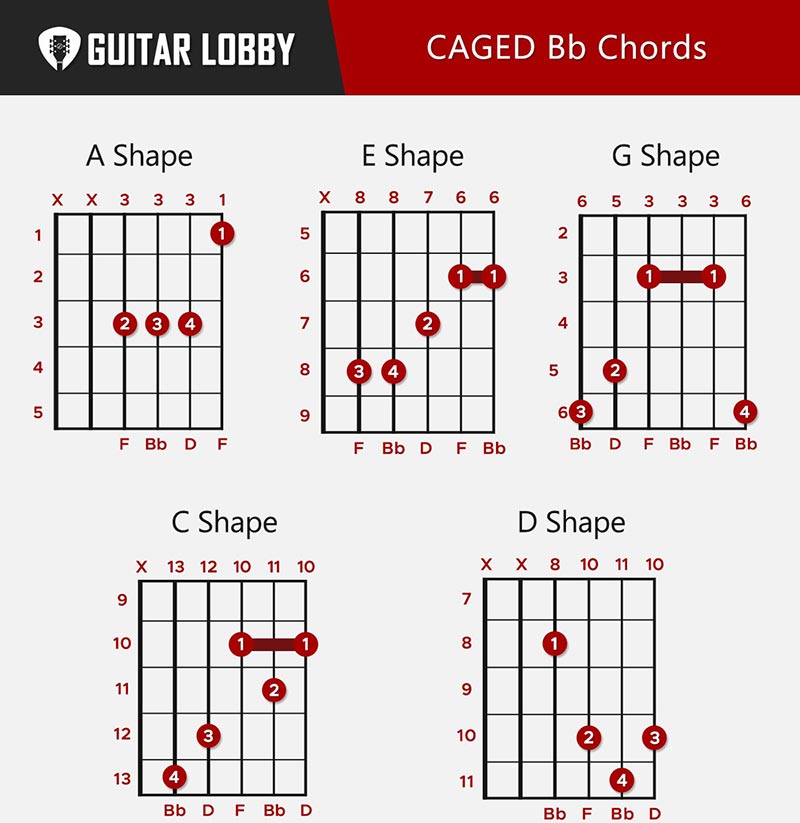
The CAGED system is a way of organizing the fretboard in which any chord is played according to 5 basic open chord shapes. The shapes as you can guess are the C, A, G, E, and D open chord shapes.
You can move those shapes up and down the fretboard, focusing on which root note to the chord you want to play. In the case of the Bb Major Caged chord you can find all the positions in the chart above.
Tips, Tricks, and Common Challenges
The CAGED system’s main challenge is memorizing and finding the root note after you’ve memorized the open chord shapes of course. For this try to name each note you play, out loud, until you know where the root Bb is in all 5 shapes.
Expert Insight
CAGED chords prove to be a great exercise for the strumming hand if you learn them properly. Try to shift to all 5 positions in one sitting and do that for every chord you know during your practice sessions.
Doing this regularly will improve your strumming hand dexterity and overall strength.
7. Bb7 Chord – Bb Blues Chord on Guitar
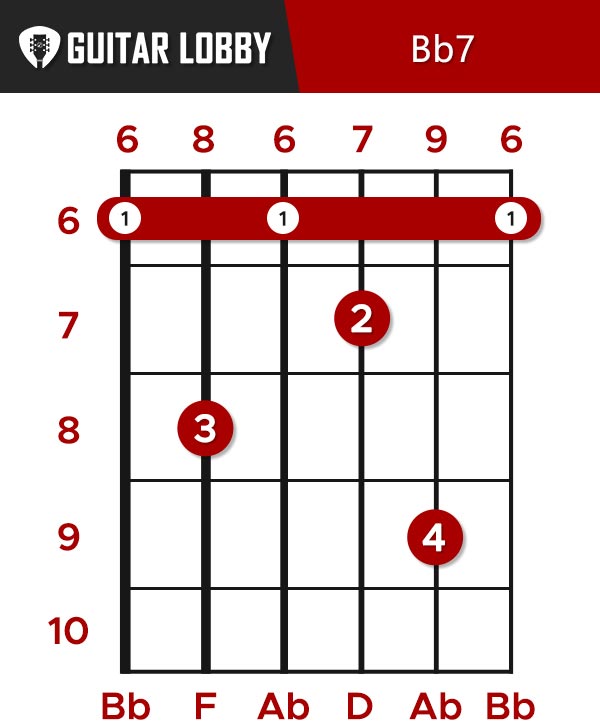
A Bb7 chord is perfect to add some blues flavor to your playing. As the other shapes of the Bb guitar chord the Bb7 chord is played with a bar.
The fingering is as follows:
- Barre all the string with your first finger (index) on the 6th fret.
- Put your second finger (middle) on the 7th fret of the G string.
- Put your third finger (ring) on the 8th fret of the A string.
- Put your fourth finger (pinky) on the 9th fret of the B String.
The only difference from the standard barre chord is the pinky position.
If you find it too difficult to place the pinky as instructed, or you want to experiment with a new sound, just don’t play anything with the pinky and leave the index finger to barre the 6th fret of the D string
What is the difference between playing the Bb major on electric and acoustic?
When playing electric, sometimes, you have to leave the bass notes to the bass guitar player. That means you should only play shapes that don’t have notes on the A and low E strings.
For the Bb Major chord, you can try to do a small bar on the 6th fret of the B and high E string and also put your middle finger on the 7th fret of G. This way you have all the 3 notes that make up the chord and stay out of the way of the bass player!
8. Bb Power Chord
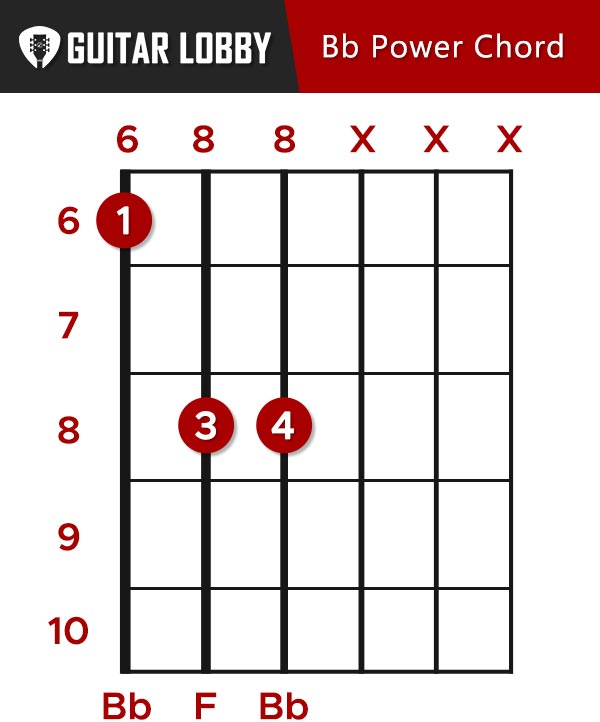
The Bb major rock chord, or as called differently Bb power chord/5th chord is not technically a major chord. The chord formula only has the 1st (root) and the 5 – without the 3rd we cannot say that the chord is major or minor.
But depending on what you are playing the chord can take a different context and it will work great in both Major and Minor situations.
The fingering is the following:
- Place your first finger (index) on the 6th fret of the Low E string.
- Place your third finger (ring) on the 8th fret of the A string.
- Place your fourth finger (pinky) on the 6th fret of the D string.
The fun thing about this chord is that you can turn up the distortion/gain of the top, and depending on how much you turn it up the chord can sound from rock n roll to metal,
Tips, Tricks, and Common Challenges
The secret to playing great power chords lies all in muting with your left hand
If you are only playing the top 3 strings then make sure your index finger is gently resting on the bottom 3. That way you can strum all the strings and get a nice chunky sound and no unwanted notes.
Final Tips on Playing the Bb Major chord:
Use a Capo. You can place a capo on the 1st fret of the guitar and imagine the Bb Major chord as if it were an A Major chord. This way you can use all open chord positions and get the tone that only open strings can achieve.
Think about the next chord. If you are Playing a Bb Major chord, choose the position depending on the chord that comes next. For example, if you have to play a C major chord after the Bb major then you might want to play the Bb major barre chord with the root on the A string to then quickly pass to the open C major shape if your goal is to play an open C major shape.
Practice strumming technique. Strumming is always fun, but sometimes if you get carried and strum too hard, chords can sound bad. What I mean is that you first need to make sure by strumming very softly that all the chord notes are ringing out nicely, then you can gradually strum harder, faster, and in various patterns.
That does it for this article, let us know if you have any questions in the comments below. We also have an entire page where you can learn easy guitar chords here that I recommend checking out.

My name is Chris and I’ve had a passion for music and guitars for as long as I can remember. I started this website with some of my friends who are musicians, music teachers, gear heads, and music enthusiasts so we could provide high-quality guitar and music-related content.
I’ve been playing guitar since I was 13 years old and am an avid collector. Amps, pedals, guitars, bass, drums, microphones, studio, and recording gear, I love it all.
I was born and raised in Western Pennsylvania. My background is in Electrical Engineering, earning a Bachelor’s degree from Youngstown State University. With my engineering experience, I’ve developed as a designer of guitar amplifiers and effects. A true passion of mine, I’ve designed, built, and repaired a wide range of guitar amps and electronics. Here at the Guitar Lobby, our aim is to share our passion for Music and gear with the rest of the music community.
